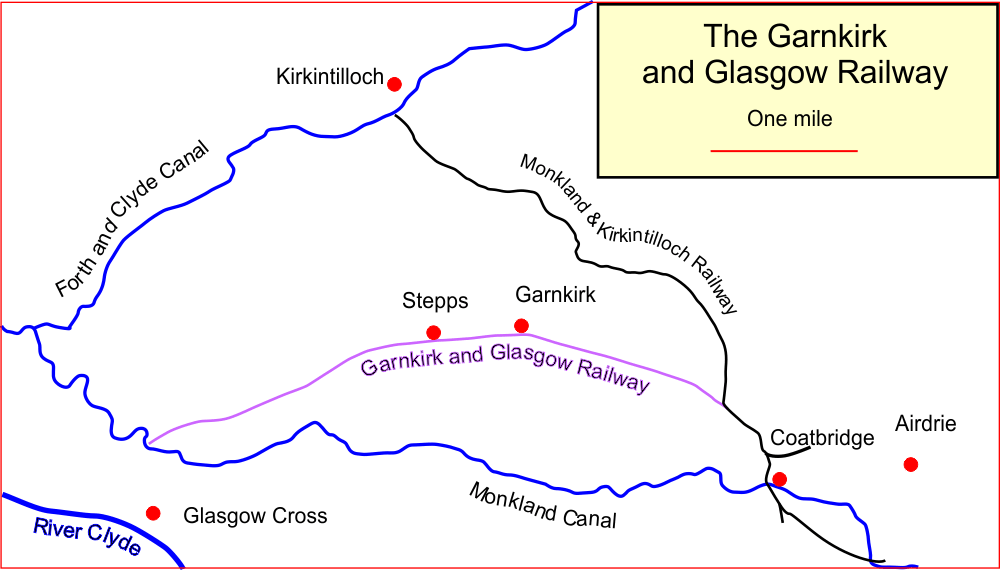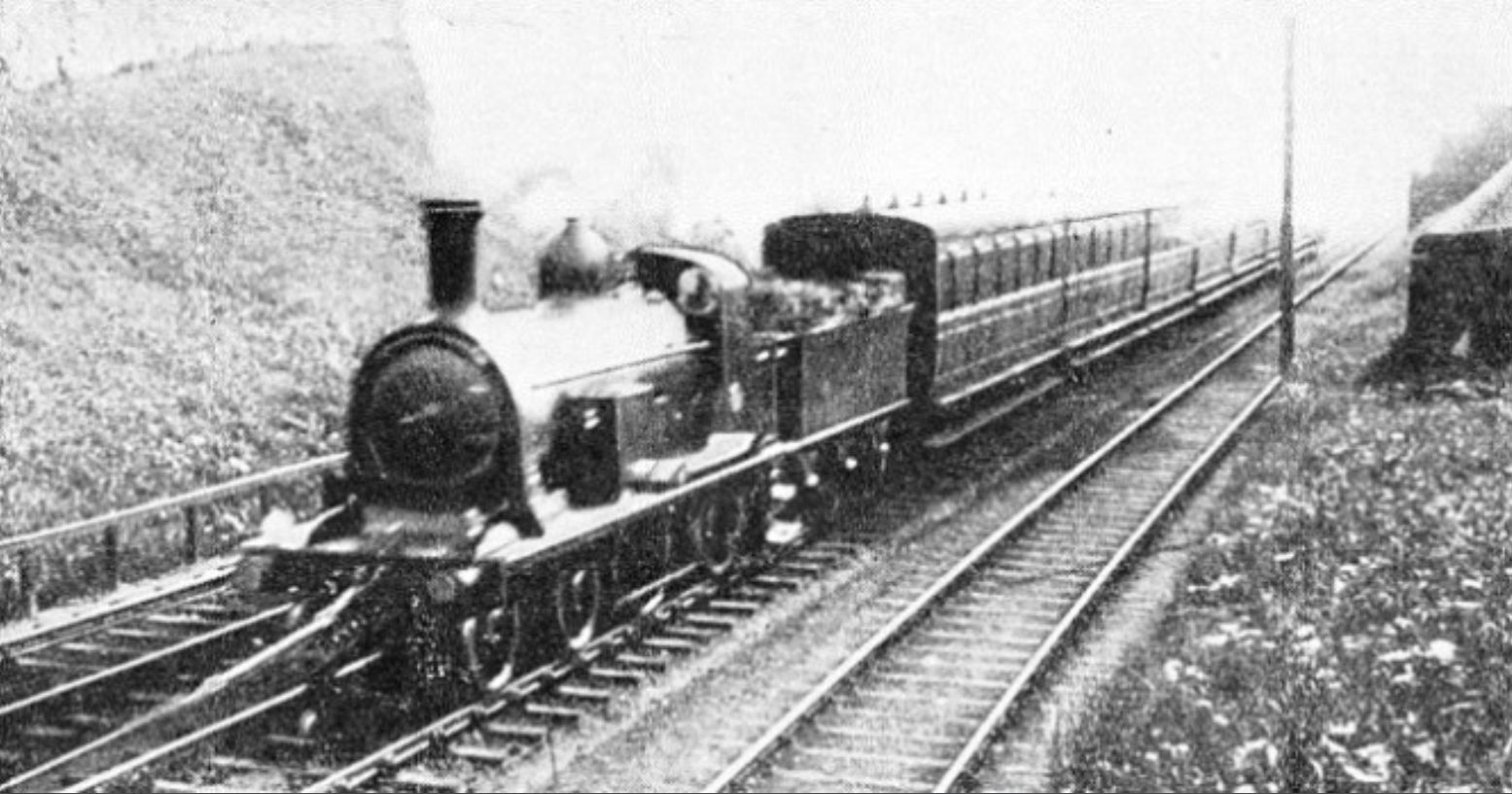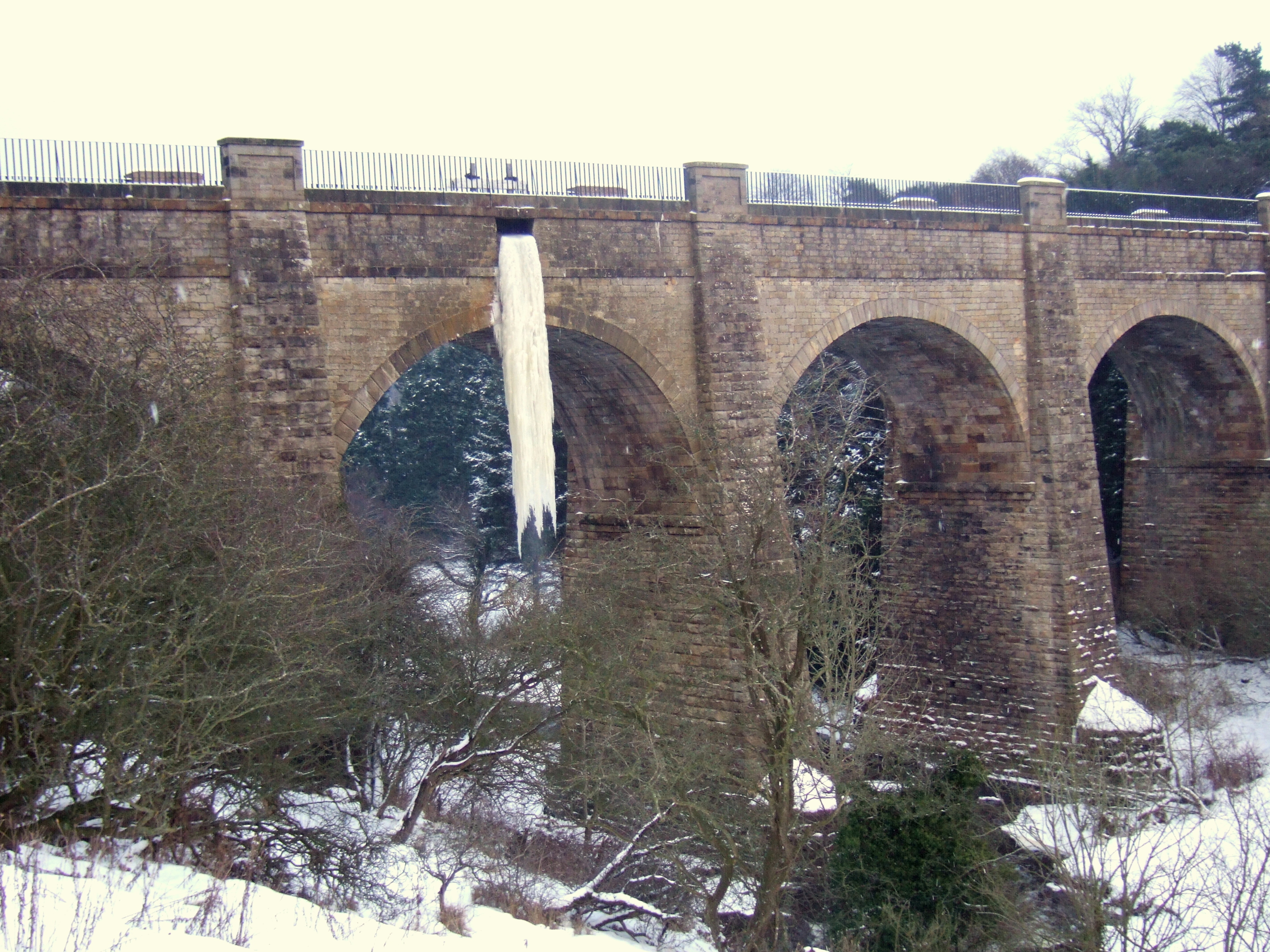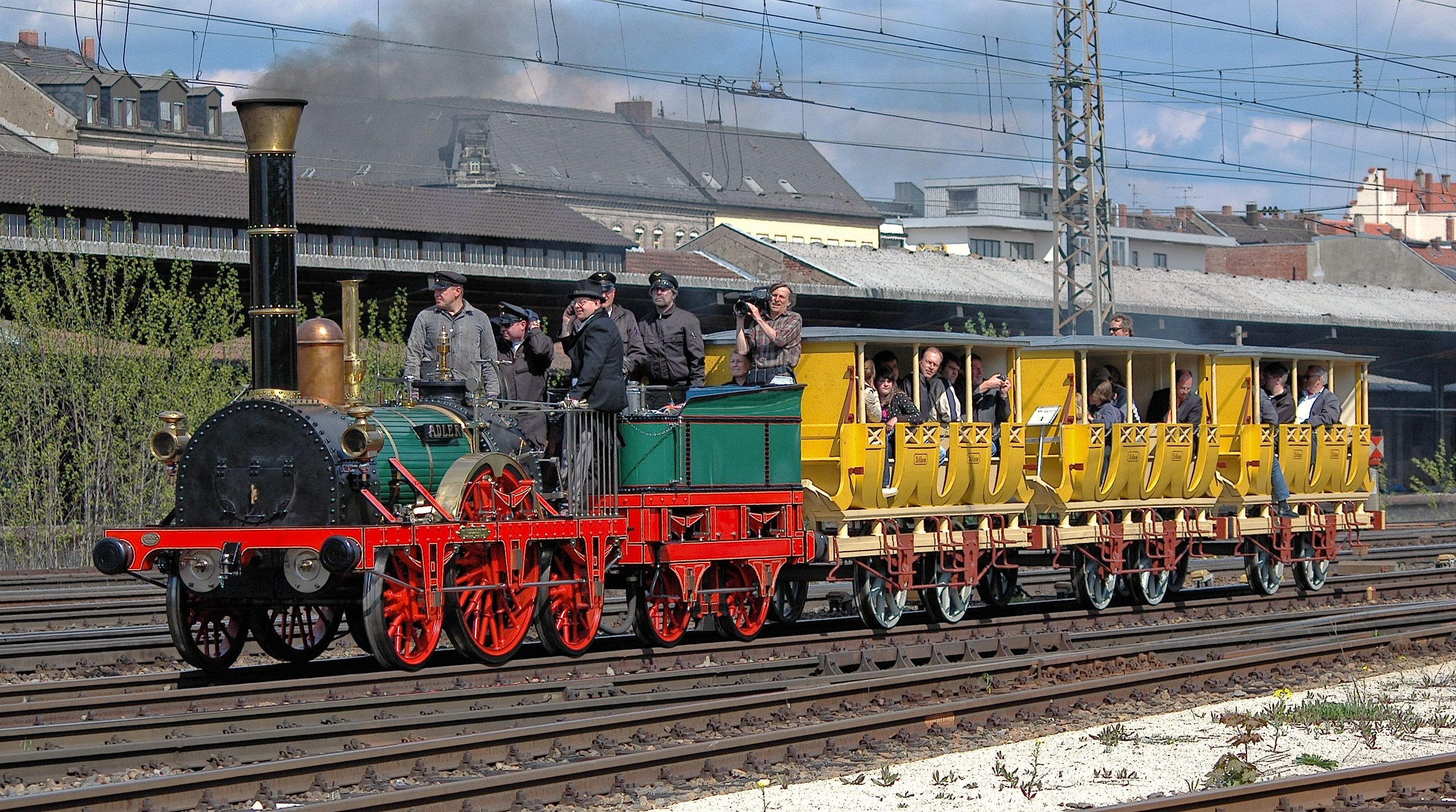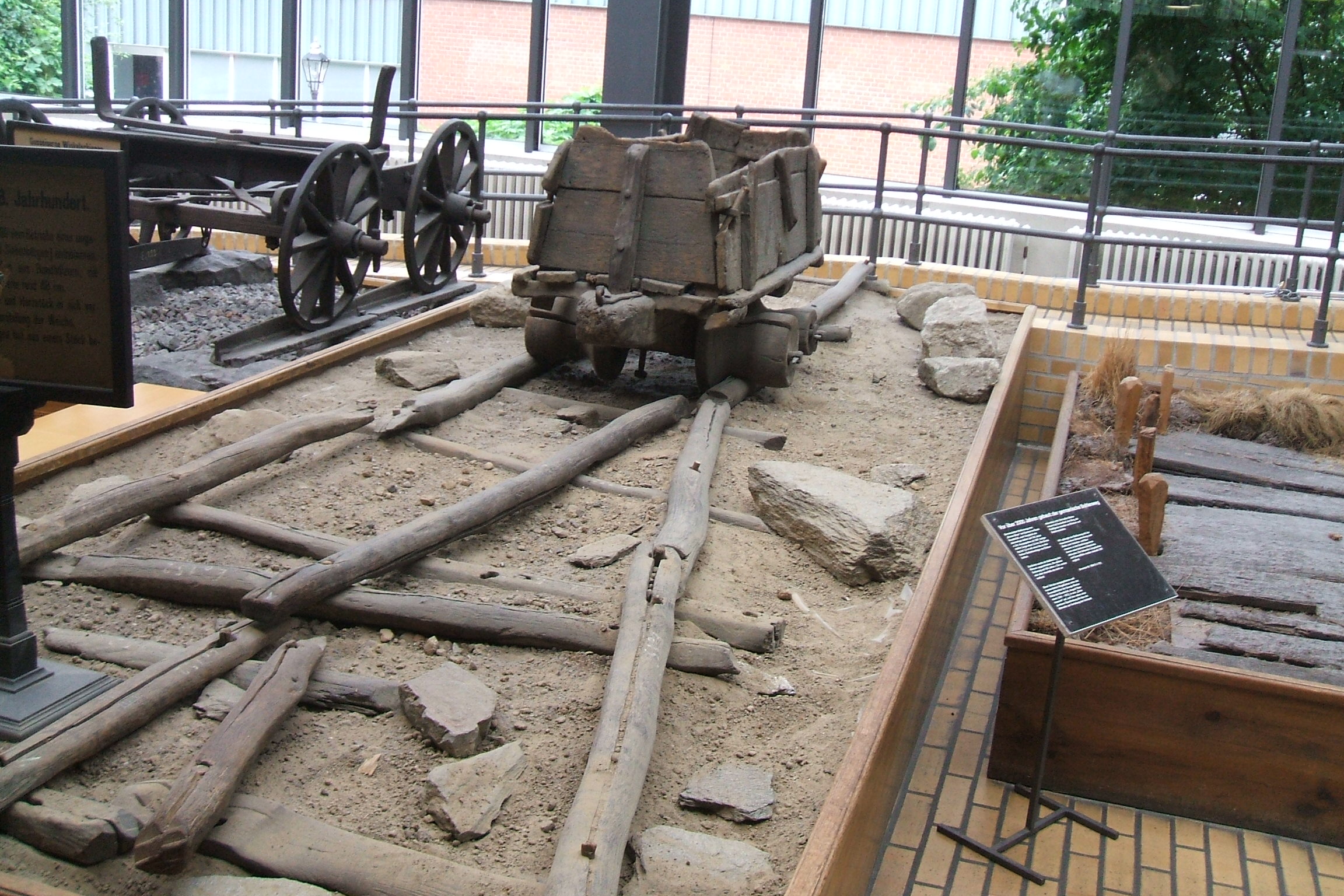|
Garnkirk And Glasgow Railway
The Garnkirk and Glasgow Railway was an early railway built primarily to carry coal to Glasgow and other markets from the Monkland coalfields, shortening the journey and bypassing the monopolistic charges of the Monkland Canal; passenger traffic also developed early in the line's existence. It opened officially on 27 September 1831 using horse traction, and had the track gauge of that had been adopted by the Monkland and Kirkintilloch Railway, with which it was to connect. It was dependent on the Monkland and Kirkintilloch Railway for access to the best areas of the coalfields, but eventually it by-passed this constraint by extending its line southwards through Coatbridge, enabling a direct link with another coal railway, the Wishaw and Coltness Railway. Widening its horizons it changed its name to the Glasgow, Garnkirk and Coatbridge Railway. The track gauge originally chosen was now a limitation and its gauge was altered to the standard of . When the Caledonian Railway advan ... [...More Info...] [...Related Items...] OR: [Wikipedia] [Google] [Baidu] |
St Rollox Chemical Works
St Rollox Chemical Works was an industrial manufacturer of chemicals located in Glasgow, Scotland, that began in 1799 and operated continuously until 1964. It was created by Scottish industrialist Charles Tennant and owned and operated by his family and descendants. It was described as the largest plant in Europe, if not the world. Formation In 1787, Tennant attended a demonstration of Claude Louis Berthollet's chlorine bleaching process that was held by Watt in Birmingham. Tennant adapted the bleaching process by substituting Lime (material), lime for potash, solving the problem of lime's inability to form a solution in water and opening the way to produce bleach. He received a patent No. 2209 on 23 January 1798 for the manufacture of a bleaching liquor by passing chlorine into a well-agitated mixture of lime and water. The new process reduced both the cost of the bleaching liquor and reduced the damage caused by the liquor to the cloth. The new liquid had a short shelf-life, ... [...More Info...] [...Related Items...] OR: [Wikipedia] [Google] [Baidu] |
M8 Motorway (Scotland)
The M8 is the busiest motorway in Scotland. It connects the country's two largest cities, Glasgow and Edinburgh, and serves other large communities including Airdrie, North Lanarkshire, Airdrie, Coatbridge, Greenock, Livingston, Scotland, Livingston and Paisley, Renfrewshire, Paisley. The motorway is long. A major construction project to build the final section between Newhouse, North Lanarkshire, Newhouse and Baillieston was completed on 30 April 2017. The motorway has one service station, Heart of Scotland services, Heart of Scotland Services, previously named Harthill due to its proximity to Harthill, Scotland, the village. History With the advent of motorway-building in the United Kingdom in the late 1950s, the M8 was planned as one of a core of new motorways, designed to replace the A8 road (Great Britain), A8 road as a high-capacity alternative for intercity travel. The motorway was constructed piecemeal in several stages bypass (road), bypassing towns, beginning in 1965 ... [...More Info...] [...Related Items...] OR: [Wikipedia] [Google] [Baidu] |
Edinburgh And Glasgow Railway
The Edinburgh and Glasgow Railway was authorised by act of Parliament on 4 July 1838. It was opened to passenger traffic on 21 February 1842, between its Glasgow Queen Street railway station (sometimes referred to at first as Dundas Street) and Haymarket railway station in Edinburgh. Construction cost £1,200,000 for 46 miles (74 km). The intermediate stations were at Corstorphine (later Saughton), Gogar, Ratho, Winchburgh, Linlithgow, Polmont, Falkirk, Castlecary, Croy, Kirkintilloch (later Lenzie) and Bishopbriggs. There was a ticket platform at Cowlairs. The line was extended eastwards from Haymarket to North Bridge in 1846, and a joint station for connection with the North British Railway was opened on what is now Edinburgh Waverley railway station in 1847. Patronage on the line quickly reached double the railway's initial estimates, and by 1850 58 locomotives and 216 coaches were needed to handle the traffic. Goods traffic started in March 1842 and slo ... [...More Info...] [...Related Items...] OR: [Wikipedia] [Google] [Baidu] |
Union Canal (Scotland)
The Union Canal, full name the Edinburgh and Glasgow Union Canal, is a canal in Scotland, running from Falkirk to Edinburgh, constructed to bring minerals, especially coal, to the capital. It was opened in 1822 and was initially successful, but the construction of railways, particularly the Edinburgh and Glasgow Railway, which opened in 1842, diminished its value as a transport medium. It fell into slow commercial decline and was closed to commercial traffic in 1933. It was officially closed in 1965. The canal is listed as three individual scheduled monuments by Historic Scotland according to the three former counties, Midlothian, West Lothian and Stirlingshire, through which it flows. It has benefited from a general revival of interest in canals and, as a result of the Millennium Link, was reopened in 2001 and reconnected to the Forth and Clyde Canal in 2002 by the Falkirk Wheel. It is now in popular use for leisure purposes. History Proposal The canal was conceived ... [...More Info...] [...Related Items...] OR: [Wikipedia] [Google] [Baidu] |
Slamannan Railway
The Slamannan Railway was an early mineral railway between the north-eastern margin of Airdrie, North Lanarkshire, Airdrie and Causewayend on the Union Canal (Scotland), Union Canal, near Linlithgow, Scotland. The Slamannan Railway was built to give access for minerals from pits in the Slamannan area to market in Glasgow (over connecting railways) and Edinburgh (over the Union Canal), and it also briefly provided an early passenger connection between Glasgow and Edinburgh in association with other railways and the canal. It had a Cable railway, rope-worked incline at Causewayend. The line opened on 31 August 1840. It crossed very thinly populated moorland, and it was dependent on promised mineral extraction on its own route, but this proved disappointing, and traffic was limited by the extended route over other railways westward, and transshipment to the canal eastward. It was never successful commercially, and in 1848 it combined with other companies, forming the Monkland Railw ... [...More Info...] [...Related Items...] OR: [Wikipedia] [Google] [Baidu] |
Robert Stephenson And Company
Robert Stephenson and Company was a locomotive manufacturing company founded in 1823 in Forth Street, Newcastle upon Tyne in England. It was the first company in the world created specifically to build Steam locomotive, railway engines. Famous early locomotives were Locomotion No. 1, ''Locomotion'' No. 1 and ''Stephenson's Rocket, Rocket''. By 1899, 3,000 locomotives had been built at the Forth Street site, and a new company was formed, Robert Stephenson and Company Limited, and the Darlington works was opened. In 1937, the company merged with R. & W. Hawthorn, Leslie and Company, Hawthorn Leslie to form Robert Stephenson and Hawthorns. In 1944, they became part of English Electric. Foundation and early success The company was set up in 1823 in Forth Street, Newcastle upon Tyne in England by George Stephenson, his son Robert Stephenson, Robert, with Edward Pease (railway pioneer), Edward Pease and Thomas Richardson (businessman), Thomas Richardson. The manager of the works b ... [...More Info...] [...Related Items...] OR: [Wikipedia] [Google] [Baidu] |
Ballochney Railway
The Ballochney Railway was an early railway built near Airdrie, North Lanarkshire, Scotland. It was intended primarily to carry minerals from coal and ironstone pits, and stone quarries, in the area immediately north and east of Airdrie, to market, predominantly over the adjoining Monkland and Kirkintilloch Railway. Passengers were carried later. Trains were pulled by horses at first, although locomotives were employed later on. The mineral extraction was located in high ground and rope-worked inclines were incorporated into the line to bring loaded wagons down. The line used the track gauge of , which was already in use on the Monkland and Kirkintilloch line. It opened in 1828, and in 1848 it amalgamated with two associated railways, forming the Monkland Railways. All of the route is now closed, although much of it can still be discovered. Origins In 1794 the Monkland Canal was completed, enabling the cheap transport of coal from the Monklands coalfields, south of Airdrie, t ... [...More Info...] [...Related Items...] OR: [Wikipedia] [Google] [Baidu] |
11 Geo
Eleven or 11 may refer to: *11 (number) * One of the years 11 BC, AD 11, 1911, 2011 Literature *Eleven (novel), ''Eleven'' (novel), a 2006 novel by British author David Llewellyn *''Eleven'', a 1970 collection of short stories by Patricia Highsmith *''Eleven'', a 2004 children's novel in The Winnie Years by Lauren Myracle *''Eleven'', a 2008 children's novel by Patricia Reilly Giff *''Eleven'', a short story by Sandra Cisneros Music *Eleven (band), an American rock band *Eleven: A Music Company, an Australian record label *Up to eleven, an idiom from popular culture, coined in the movie ''This Is Spinal Tap'' Albums *11 (The Smithereens album), ''11'' (The Smithereens album), 1989 *11 (Ua album), ''11'' (Ua album), 1996 *11 (Bryan Adams album), ''11'' (Bryan Adams album), 2008 *11 (Sault album), ''11'' (Sault album), 2022 *Eleven (Harry Connick, Jr. album), ''Eleven'' (Harry Connick, Jr. album), 1992 *Eleven (22-Pistepirkko album), ''Eleven'' (22-Pistepirkko album), 1998 *Eleven ... [...More Info...] [...Related Items...] OR: [Wikipedia] [Google] [Baidu] |
John Birkinshaw
John Birkinshaw (1777–1842) was an English railway engineer from Bedlington, Northumberland, noted for his invention of wrought iron rails in 1820 (patented on October 23, 1820). Up to this point, rail systems had used either wooden rails, which were totally incapable of supporting steam engines, or cast iron rails typically only in length. These cast iron rails, developed by William Jessop and others, only allowed very low speeds and broke easily and although steam locomotives had been tested as early as 1804 by Richard Trevithick, these experiments had not been economically successful as the rails frequently broke. "John Birkinshaw's 1820 patent for rolling wrought-iron rails in 15ft lengths was a vital breakthrough for the infant railway system. Wrought iron was able to withstand the moving load of a locomotive and train unlike cast iron, used for rails until then, which was brittle and fractured all too easily." Birkinshaw's wrought iron rails were taken up by George Ste ... [...More Info...] [...Related Items...] OR: [Wikipedia] [Google] [Baidu] |
Fish Bellied Rail
The railway track or permanent way is the elements of railway lines: generally the pairs of rails typically laid on the sleepers or ties embedded in ballast, intended to carry the ordinary trains of a railway. It is described as a permanent way because, in the earlier days of railway construction, contractors often laid a temporary track to transport spoil and materials about the site; when this work was substantially completed, the temporary track was taken up and the permanent way installed. The earliest tracks consisted of wooden rails on transverse wooden sleepers, which helped maintain the spacing of the rails. Various developments followed, with cast iron plates laid on top of the wooden rails and later wrought iron plates or wrought iron angle plates (angle iron as L-shaped plate rails). Rails were also individually fixed to rows of stone blocks, without any cross ties to maintain correct separation. This system also led to problems, as the blocks could individually move ... [...More Info...] [...Related Items...] OR: [Wikipedia] [Google] [Baidu] |
Germiston, Glasgow
Germiston is a neighbourhood in the city of Glasgow, Scotland, north of the River Clyde. The area forms part of the suburb of Springburn for political purposes, but is more commonly referred to as part of the 'Royston Road corridor' flanked by the Cumbernauld Line railway and the M8 motorway (previously the Monkland Canal), its location midway between Blackhill to its east and Royston (Garngad) to its west earning it a position as the 'wee sister' of both of those better-known neighbourhoods. History It formerly centred around Germiston House, a mansion built in 1690 by Robert Dinwiddie, a tobacco lord in Virginia and father of Robert Dinwiddie, governor of Virginia, and Lawrence Dinwiddie, Lord Provost of Glasgow, both of whom were born there. Lawrence Dinwiddie inherited the house and raised his 21 children there. In 1864, the house was acquired by Rev Dr George Stewart Burns, minister of Glasgow Cathedral. The setting of the house was ruined by a railway line being p ... [...More Info...] [...Related Items...] OR: [Wikipedia] [Google] [Baidu] |
